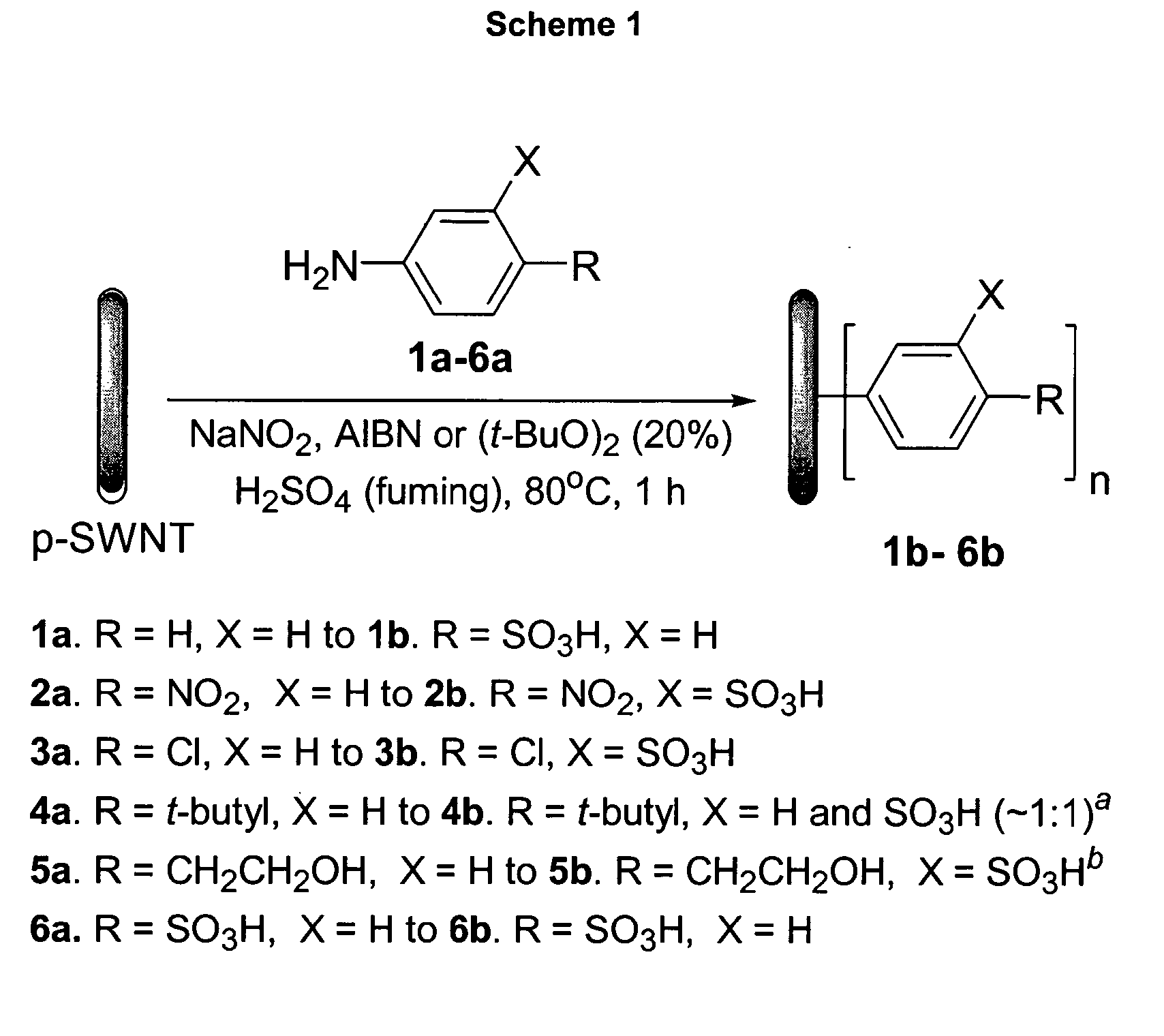Functionalization of Carbon Nanotubes in Acidic Media
a carbon nanotube and acidic media technology, applied in the field of carbon nanotubes, can solve the problems of limited documented results in this new field of chemistry, difficult scaling, and relatively poor reactivity
- Summary
- Abstract
- Description
- Claims
- Application Information
AI Technical Summary
Benefits of technology
Problems solved by technology
Method used
Image
Examples
example 1
[0055] This Example serves to illustrate the functionalization of SWNTs in oleum via diazonium species generated in situ from 6a (FIG. 1), and the characterization of such functionalized species, in accordance with embodiments of the present invention.
[0056] Purified single wall carbon nanotubes (0.050 g, 4.2 mmol), (purified according to Chiang et al., J. Phys. Chem. B 2001, 105, 8297) were dispersed in oleum (50 mL, 20% free SO3) at 80° C. This dispersion was then filtered over glass wool to remove any large particulates. Sulfanilic acid (6a, 2.91 g, 16.8 mmol) was added to the dispersion followed by sodium nitrite (1.16 g, 16.8 mmol). Finally 2,2′-azo-bis-isobutyrylnitrile (AIBN, 1.38 g, 8.4 mmol) was added to provide a radical source. This solution was allowed to stir at 80° C. for one hour at which point the reaction mixture was poured into 300 ml of water. This mixture was then filtered over a polycarbonate membrane filter (1 μm pore size), and washed with 500 mL of acetone. ...
example 2
[0059] This Example serves to illustrate the functionalization of SWNTs in oleum via diazonium species generated in situ from 3a (FIG. 1), and the characterization of such functionalized species, in accordance with embodiments of the present invention.
[0060] Purified-SWNTs (p-SWNT, 50 mg, 4.2 milliequiv. of carbon) were dispersed in oleum (50 mL, 20% free SO3, Aldrich) with magnetic stirring (3 hours). Sodium nitrite (1.16 g, 16.8 mmol) was added followed by 4-chloroaniline (3a) (2.14 g, 16.8 mmol) and azobisisobutyronitrile (AIBN) (0.14 g, 0.84 mmol) (AIBN and di-tert-butylperoxide produced similar results; however, degrees of arylation were about 50% greater using AIBN). The reaction was stirred at 80° C. for 1 hour, then carefully poured into water and the suspension filtered through a polycarbonate membrane (1 μm). The filter cake was washed with water and acetone, and then dried (55 mg of 3b). The solid (3b) could be dispersed as individuals (unroped) in a variety of solvents ...
example 3
[0066] This example illustrates functionalization of SWNTs with diazonium species in 96% sulfuric acid using persulfates, in accordance with embodiments of the present invention.
[0067] SWNTs (10 mg) are added to a round-bottom flask and 96% sulfuric acid (30 mL), along with the persulfate (ammonium or potassium, 1.3 equiv. to water in 96% H2SO4), is added. The solution is homogenized until the solution becomes black. Homogenization is done using a modular system with a shaft and generator assembly powered by a rotating motor (Dremel®). The shaft and generator assembly are introduced into the solution and the motor spins the assembly at ˜5000 rpm causing shear in the solution and effectively dispersing the SWNTs. Then, an aniline derivative is added (2 equiv.) followed immediately by sodium nitrite (2 equiv.). The solution is then homogenized either at room temperature (RT) or 80° C. for 1-12 hours. Workup is done by pouring the resulting solution / suspension over ice and filtering. ...
PUM
| Property | Measurement | Unit |
|---|---|---|
| diameters | aaaaa | aaaaa |
| pore size | aaaaa | aaaaa |
| diameters | aaaaa | aaaaa |
Abstract
Description
Claims
Application Information
 Login to View More
Login to View More - R&D
- Intellectual Property
- Life Sciences
- Materials
- Tech Scout
- Unparalleled Data Quality
- Higher Quality Content
- 60% Fewer Hallucinations
Browse by: Latest US Patents, China's latest patents, Technical Efficacy Thesaurus, Application Domain, Technology Topic, Popular Technical Reports.
© 2025 PatSnap. All rights reserved.Legal|Privacy policy|Modern Slavery Act Transparency Statement|Sitemap|About US| Contact US: help@patsnap.com



